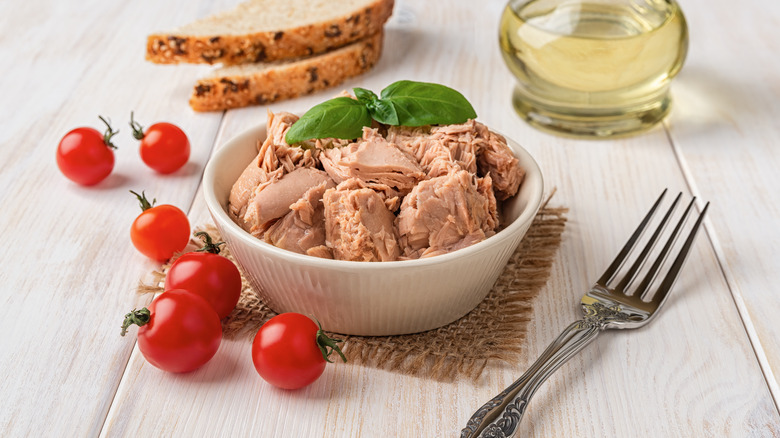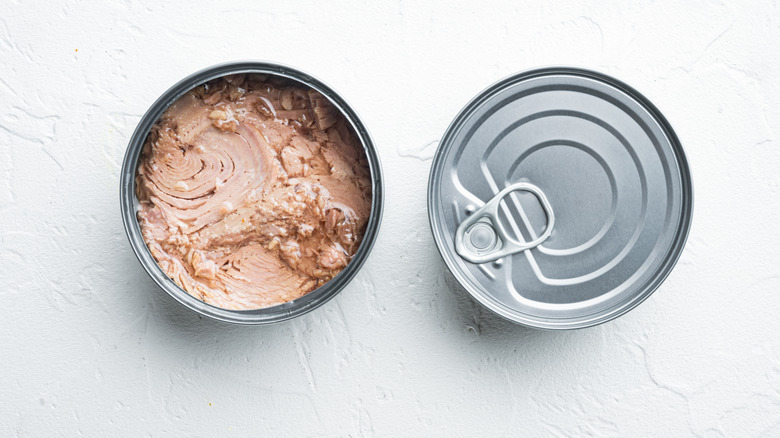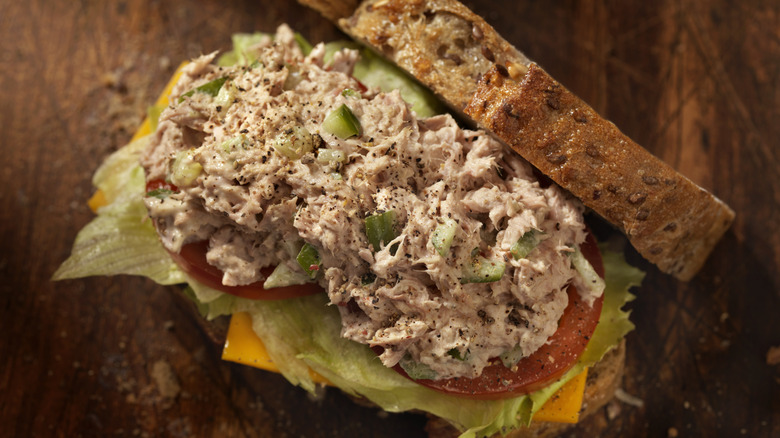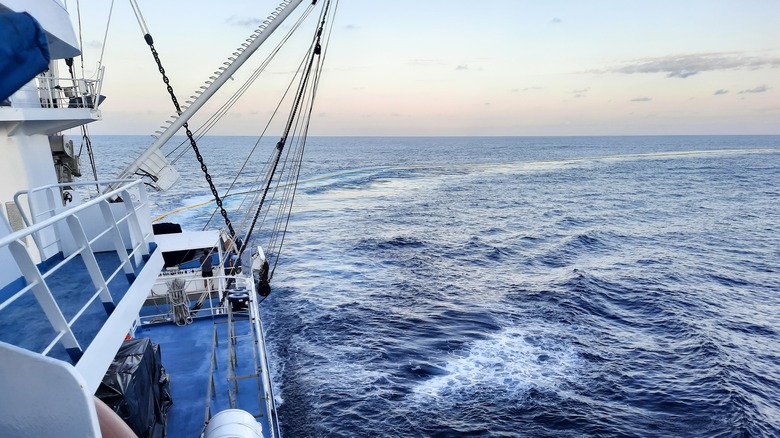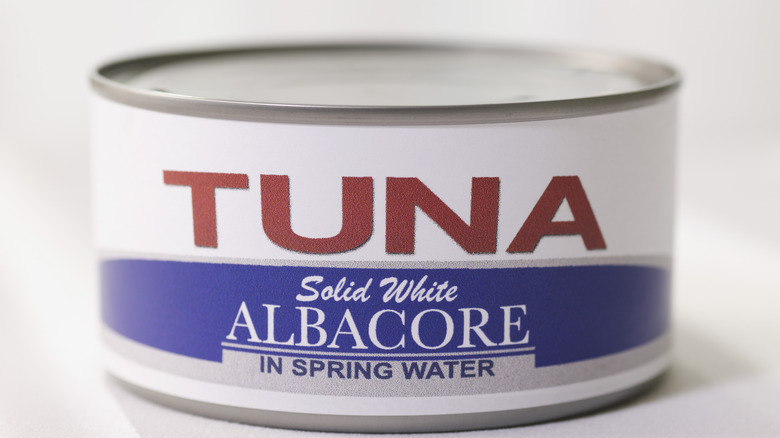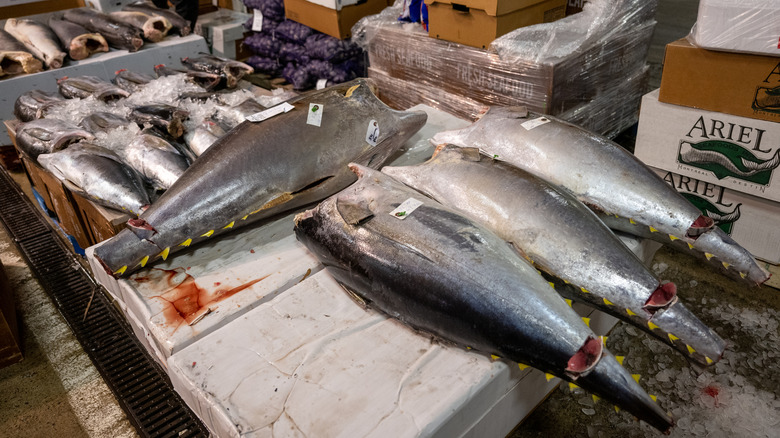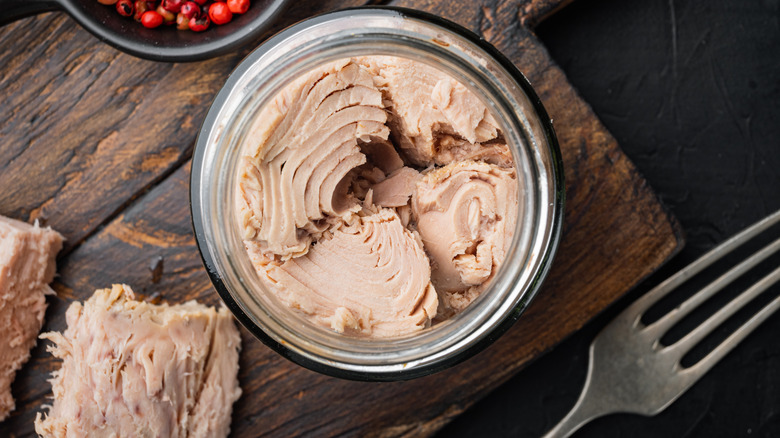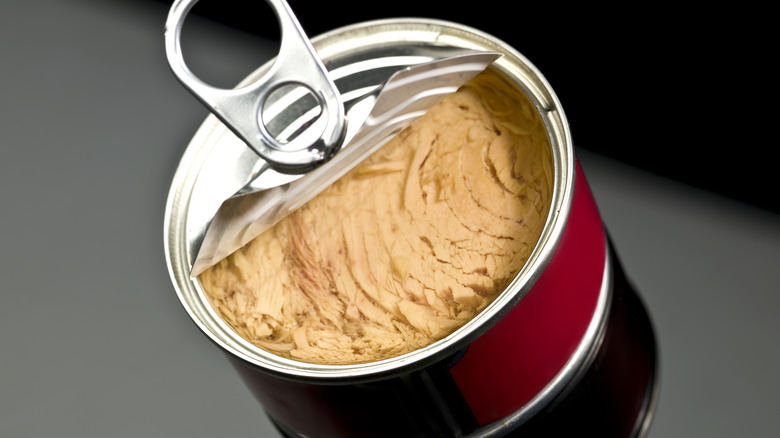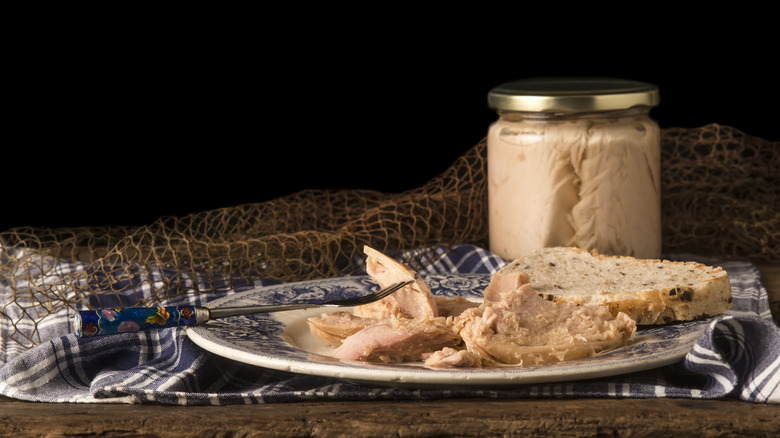All Your Questions About Canned Tuna, Answered
Believe it or not, canned tuna is having a moment. Regular viewers of TikTok have been seeing more fishy content celebrating the wonders of canned tuna and other canned fish varieties. And canned tuna has become a hit with young influencers for many of the same reasons it was an omnipresent staple in their grandmothers' pantries – it's shelf-stable, (mostly) affordable, and nutritious. And, of course, it's tasty.
If you take a close look at your supermarket's canned fish section, you'll notice a lot more variety than before — besides the familiar cans, you'll see cooked tuna in vacuum pouches and even in glass jars. You might see canned tuna salads with seasonings or vegetables already included. On top of that, you might have heard some debate about it — is it true canned tuna contains unhealthy quantities of mercury, for instance? And isn't tuna fishing environmentally irresponsible? But don't let all this overwhelm you — here's what you need to know about today's canned tuna.
Is canned tuna healthy?
Home cooks have long considered canned tuna an affordable source of quality protein, and they were right: It really does deliver when it comes to nutrition. A 100-gram serving of canned tuna offers up almost 25 grams of protein (and fresh tuna is even better, with roughly 32 grams of protein per serving). Tuna is also naturally low in fat — tuna canned in water contains just 1 gram of fat per 100 gram serving. Taken together, this makes canned tuna a great choice for those looking to control their weight.
But canned tuna has numerous other nutritional benefits. It's a good source of taurine, an amino acid that offers protection against heart disease. It also contains beneficial levels of B vitamins such as niacin, which helps build the skin and nervous system. And it has healthy omega 3 fatty acids, which provide important support for the cardiovascular and immune systems, among other functions. In addition, canned tuna is also a good source of calcium and vitamin D.
Is canned tuna safe?
While canned tuna has long had a reputation for being flavorful and nutritious, in recent years, it's gained some notoriety for containing mercury, a metal that's toxic to humans. Mercury poisoning can cause problems such as vision loss, loss of motor control, muscle weakness, and speech issues. None of this is the fault of the fish, but of the polluted environments in which they live: Mercury from industrial waste and other sources makes its way into waterways, where fish take it in either through their gills or through mercury-tainted food.
Large fish such as tuna absorb mercury from the smaller fish they eat; the older and bigger the fish, the more mercury they potentially keep concentrated in their flesh. This means when we eat tuna, we run the risk of consuming this mercury too. This is disturbing to know, but in reality, the levels of mercury in canned tuna (unless you are eating it in abundance) are too low to pose much of a risk to most people. However, those who are pregnant or trying to become pregnant should enjoy their tuna in moderation – Britain's National Health Service recommends pregnant women limit themselves to four cans of tuna or two tuna steaks a week. If you enjoy canned tuna but want more peace of mind, seek out brands that monitor the mercury levels of their fish.
How about canned tuna sustainability?
Sustainability is a serious concern for thoughtful seafood lovers. As much as we love our canned tuna, nobody wants to harvest tuna to the point of extinction or otherwise degrade the marine ecosystems they and other fish need for survival. But the popularity of canned tuna means heavy commercial pressure to obtain a ready supply of fish. As a result, overfishing has put some commercially popular species of tuna, such as bigeye, skipjack, albacore, and yellowfin, at risk. This isn't just bad news for the tuna: Without sufficient numbers of large predatory fish such as tuna, populations of smaller prey fish may explode, throwing entire ecosystems out of balance. In addition, the significant bycatch that comes with some methods of tuna fishing also means lost fish populations — and sometimes the unnecessary deaths of sea turtles and seafaring birds.
However, both conservationists and fishing professionals acting out of enlightened self-interest are working to make tuna fishing more sustainable by practicing more selective methods of fishing and refraining from overfishing. If you want to be sure your canned tuna was responsibly harvested, look for the terms pole caught, pole-and-line caught, school-caught, troll-caught, FAD free, or free school on the label. These indicate fishing methods that minimize bycatch.
Oil-packed vs. water-packed tuna -- which is better?
Even if you've always been happy to grab the nearest can of tuna on the shelf, you've probably noticed the terms "oil-packed" or "water-packed" on the label. They mean exactly what they sound like — some varieties of canned tuna come packed in oil (which can be anything from soybean to extra-virgin olive oil), while others are simply packed in water. The choice of packing liquid does matter, and while both types have their fans, the right choice for you will depend on your tastes and what you plan to do with the tuna.
An obvious advantage to water-packed tuna is it's less fattening. And since the water doesn't contribute any flavor of its own, water-packed tuna allows other seasonings you use to shine without interference, making it a good choice for casseroles or pasta sauces. However, some feel water-packed tuna tends to be mushy and less flavorful, since much of the fish's flavor leaches out into the water. For these folks, oil-packed tuna, which tends to be moister and more flavorful, is their option of choice, especially if it's going to be enjoyed straight from the can without heavy sauces or dressing.
Does tuna species matter?
Unless you're a serious seafood nerd, you've probably never given much thought to the species of tuna in your can, despite it often being specified on the label. After all, have you ever met anyone (apart from maybe your fishmonger) who actually writes "albacore" on their shopping list? But if you're picky about your tuna and want to avoid surprises or disappointment, understanding the difference between the most popular species can help you make the right choice every time.
Albacore is a popular species for canned tuna, and has a pale color and mild, briny flavor – so look for this if you don't like tuna that smells or tastes strongly fishy. But if you love more boldly flavored tuna, go for skipjack or yellowfin – both are softer than albacore as well as darker in color (pinkish rather than whitish). Bigeye, like albacore, has a firm texture, but a slightly more pronounced flavor. And if you're pregnant or trying to get pregnant, look for tongol — it has lower levels of mercury than other tuna types, as well as a pleasantly mild flavor.
What do terms like chunk and white mean on tuna labels?
It's easy to gloss over the common terminology on canned tuna labels, since the terms "chunk light," "white," and "light" don't sound all that mysterious. But like much industry-specific terminology, the terms don't mean exactly what you might think. While they do refer to the relative color and texture of the tuna in the can, they do so in unexpected ways.
The term "white" on tuna cans, for example, doesn't just mean you'll find pale-colored fish in your can – it means you'll get albacore specifically. Indeed, in the United States, only albacore can be marketed as white tuna. (Ironically, while albacore is paler than other tuna varieties, unless fish such as sole or cod, it's not actually white, but a very pale pink.) While the term "white" on tuna cans is highly specific, "light" covers more ground: It can refer to either skipjack or skipjack mixed with bigeye, yellowfin, or other species. And if you open a can of "chunk light" tuna expecting big chunks of fish, you're going to be disappointed — it refers to light tuna in small pieces, rather than fillets, so you're likely to find flakes rather than chunks.
How long can I keep canned tuna in the pantry?
Both savvy cooks and the kitchen-averse know that if you've got a can of tuna in the pantry, you've got the makings of a meal — this is why many of us keep it on hand for those times when we're too busy to cook or shop. Unfortunately, this also makes our dependable canned tuna stash easy to forget. If you've rummaged through the back of your pantry and discovered a can of tuna that expired during the Obama administration, don't feel bad — you're not the only one.
And you don't have to worry about wasting food. If your old can is in good condition (no bulging, leaking, rust, swelling, or dents), there's a good chance the tuna inside is still perfectly safe to eat. This is because a properly sealed can offers a sterile, stable environment, meaning nothing can get in to degrade the quality of the tuna. Most producers say their canned tuna can maintain its quality for up to five years after canning, and it's possible for cans to retain their quality and safety even after that. So go ahead and open that old can — if it smells and looks like regular tuna, you're good to go. But if it smells off, looks discolored, or if the can pops or explodes when opened, dump it stat.
Why are canned tuna prices all over the map?
A quick survey of the canned tuna section in a well-stocked supermarket will reveal an embarrassment of riches. You'll find everything from bargain-brand basic cans to pouches of seasoned tuna to glass jars of tuna fillets. Just as varied as your choices are also their prices — at Wal-Mart, for instance, you can get both a 5-ounce can for under a dollar and a 6.7-ounce jar of yellowfin for $6.58.
There are rational reasons for this variation. White (all-albacore) tuna tends to be pricier because it's more popular; while light tuna (made from a mixture of species) is less expensive. Similarly, canned tuna in fillets is more expensive than tuna in chunks or flakes. Tuna in glass jars is pricy for a number of reasons – it typically contains more expensive whole fillets, and glass jars are more expensive to procure and ship. In addition, some premium brands of canned tuna feature fillets immersed in extra-virgin olive oil, which adds to the price tag.
Is pricy jarred tuna worth it?
The concept of tuna in glass jars rather than cans may seem counterintuitive. Even more counterintuitive is the idea of paying significantly more for what most of us consider casual budget food. Yes, many producers of jarred tuna position themselves as purveyors of premium products, but you might be wondering if the difference in quality is enough to justify the high price tag.
The answer will depend on how picky you are about your tuna. Jarred tuna comes oil-packed in whole fillets, which means you get big, meaty chunks that are moister and more flavorful than plain water-packed canned tuna. In addition, the large fillets are ideal for preparations where the appearance of the tuna matters, such as salade Niçoise. Jarred tuna from Italy is long-marinated in extra-virgin olive oil, adding another dimension of richness and flavor. It will make an obvious difference if you're planning to enjoy the tuna on its own or only lightly embellished. But whether or not it will make a life-changing difference in an average tuna melt is up for you and your palate to decide.
What can I make with canned tuna besides sandwiches, salads, and casseroles?
If you regularly keep canned tuna on hand, you probably have a few back-pocket recipes for using it — perhaps your family's tuna salad or tuna melt recipe, or maybe a favorite tuna casserole. Tasty as they are, your family's starting to get bored with these, and you're wondering if there are other ways to change up and elevate your dependable can of tuna.
You're in luck! Because you just have to look beyond the classic American canon of sandwiches and casseroles. For example, canned tuna is the star ingredient in South American tuna empanadas, a popular Lenten dish. For the filling, canned tuna is mixed with capers and sautéed garlic, onions, bell pepper, and oregano. Mixed with mayo and sriracha, canned tuna also makes a tasty filling for onigiri, or Japanese rice balls – simply wrap a handful of cooked, seasoned sushi rice around a spoonful of the filling. To turn your can of tuna into a dinner to impress, make vitello tonnato – a classic Italian dish of cold, poached veal slices napped with a creamy sauce of pureed canned tuna, anchovies, eggs, capers, and olive oil.

